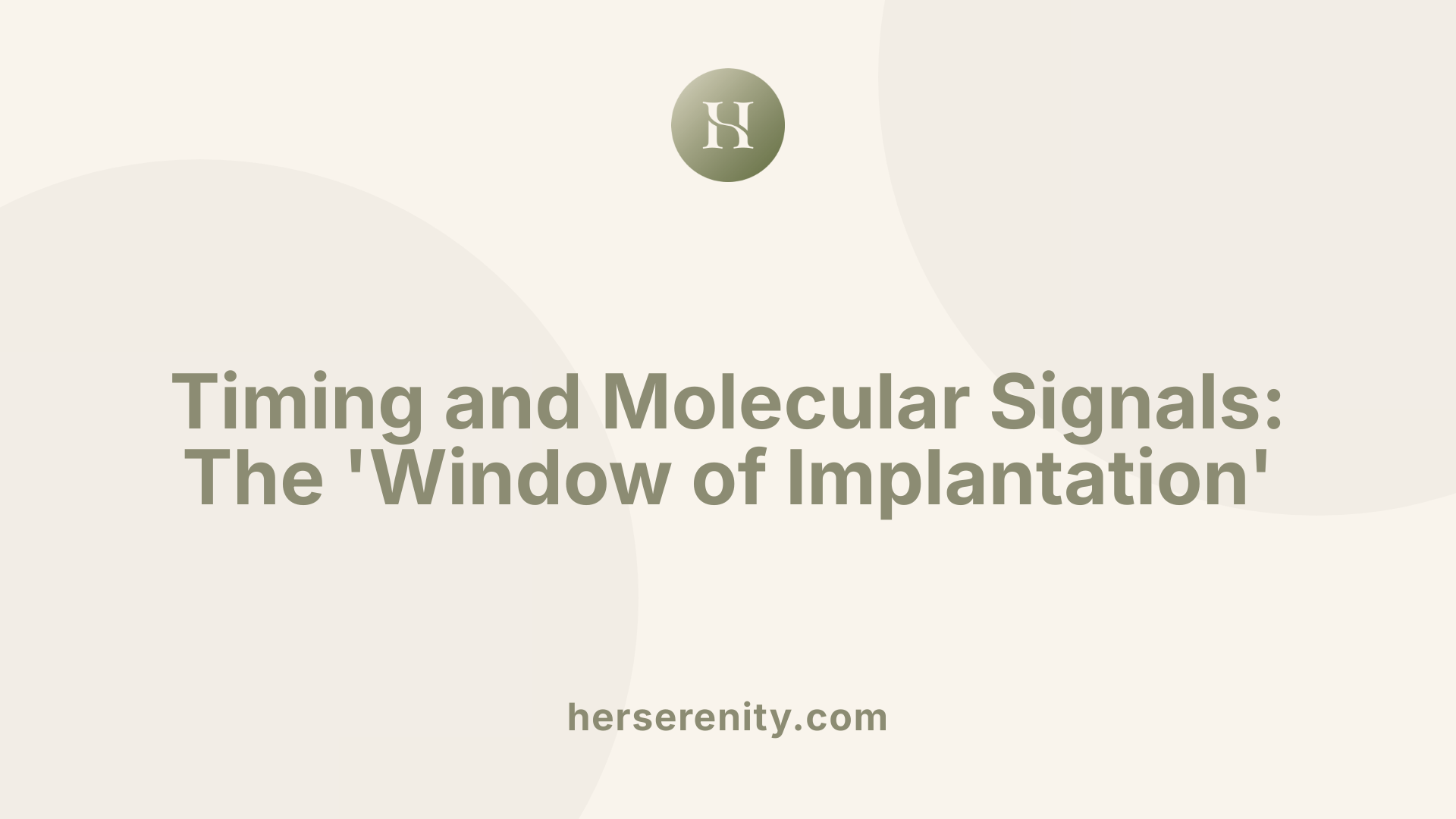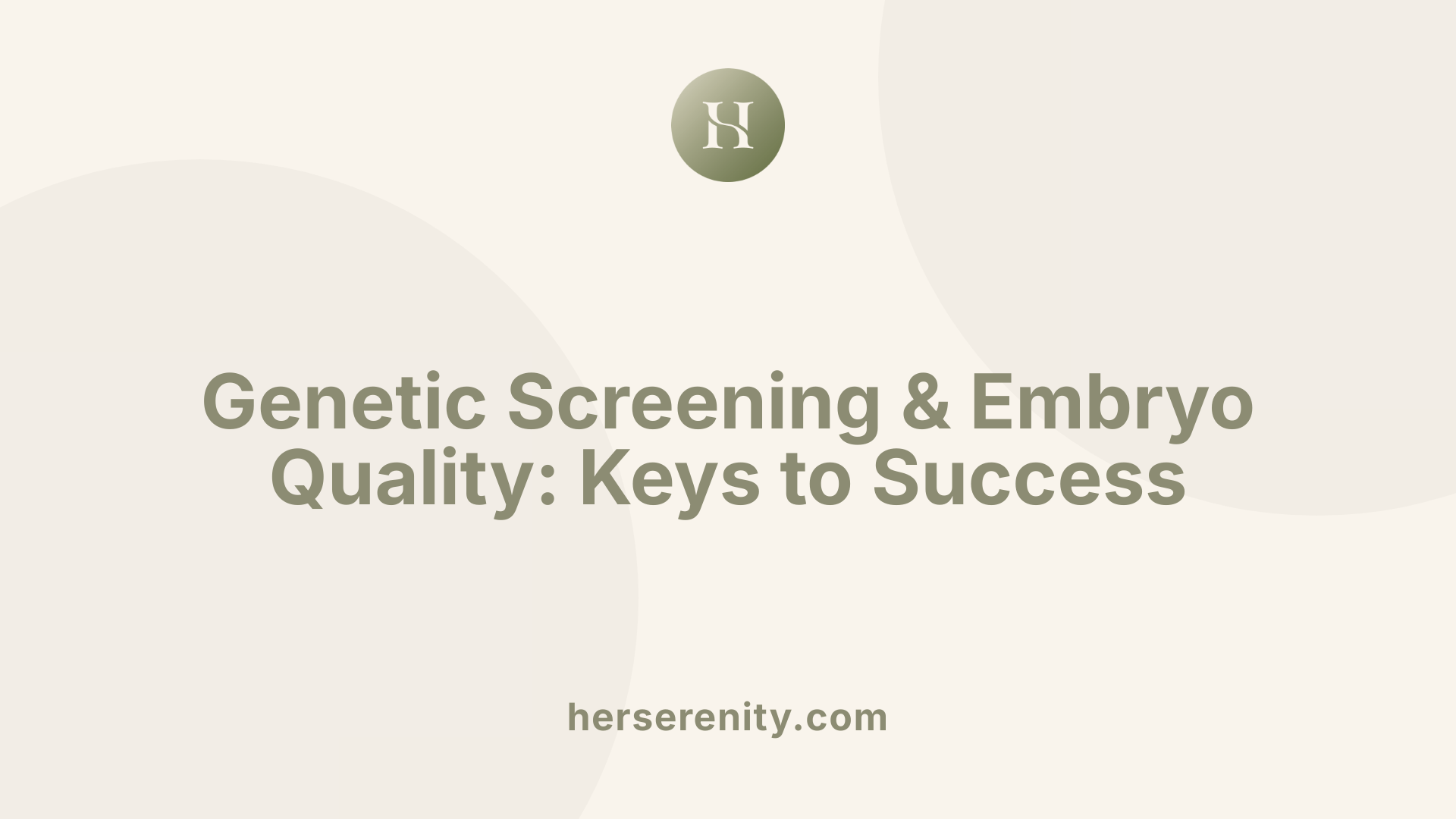Navigating the Complexities of Implantation Failure
Implantation failure presents one of the most challenging hurdles in assisted reproduction. Defined typically as the failure of good quality embryos to implant after multiple in vitro fertilization (IVF) cycles, often three or more, it poses emotional and clinical difficulties for individuals and couples trying to conceive. This article explores the multifaceted causes of implantation failure, including embryonic, uterine, immunologic, and male factors, and discusses current and emerging medical approaches to address these challenges. We aim to provide a comprehensive guide on understanding implantation failure and outline practical next steps to enhance the chances of successful conception.
Defining Repeated Implantation Failure (RIF)
What is repeated implantation failure (RIF)?
Repeated implantation failure (RIF) is characterized by the failure of good quality embryos to implant successfully after multiple IVF attempts. Specifically, the diagnosis is generally applied after at least three consecutive IVF cycles with high-quality embryos fail to result in pregnancy. This definition emphasizes that the embryos transferred are of adequate quality, distinguishing RIF from failures due to embryo defects or poor embryo quality.
Criteria for RIF diagnosis
The most commonly accepted criterion for RIF is failure to achieve pregnancy after three consecutive IVF cycles involving the transfer of good quality embryos. Other important considerations include the maternal age and the stage of the embryo transferred. RIF diagnosis also takes into account a proper evaluation of the uterine environment to rule out anatomical or other uterine factors influencing implantation.
Statistics on implantation success rates
Implantation rates vary widely depending on factors like maternal age and embryo quality. On average, only about 25% of embryos transferred during IVF successfully implant and lead to a live birth. For women under 35 years of age, the implantation rate is higher, approximately 43%. However, this rate declines sharply with advancing age — for women aged 41 to 42, implantation success drops to about 9%, largely due to increasing chromosomal abnormalities in eggs and embryos. These statistics underscore the challenges faced by couples experiencing RIF, emphasizing the importance of accurate diagnosis and targeted treatment strategies.
The Implantation Process: Key Biological Interactions

How do the embryo and endometrium communicate during implantation?
Successful implantation requires a dynamic dialogue between a healthy embryo and a receptive endometrium. This cross-talk involves a complex exchange of molecular signals that ensure the embryo can attach and develop within the uterus. The embryo releases mediators that influence the endometrium, while the endometrial lining responds by expressing specific proteins and chemokines to support implantation.
What role does the maternal immune system play?
The maternal immune system is intricately involved in implantation, balancing tolerance toward the semi-allogeneic embryo and immune defense to maintain uterine health. Immune cells and cytokines from both the mother and embryo coordinate to create an environment that supports embryo acceptance. Disruptions in immune signaling or imbalances in cytokine profiles can hinder implantation success.
Why is the 'window of implantation' important?
The 'window of implantation' refers to a limited period when the endometrium is optimally receptive to embryo attachment. This typically occurs when the endometrium reaches an appropriate thickness, usually between 6 and 8 millimeters. During this window, molecular markers such as integrins and leukemia inhibitory factor (LIF) peak, allowing maximal receptivity. Timing embryo transfer within this window is critical for increasing chances of implantation.
Through finely tuned communication, immune modulation, and temporal readiness, the implantation process sets the foundation for a successful pregnancy. Understanding these biological interactions is vital in addressing implantation failures and improving fertility treatments.
Embryo Quality and Genetic Factors Affecting Implantation

Chromosomal abnormalities and maternal age
Embryo quality is crucial for successful implantation, with genetic factors playing a significant role. Chromosomal abnormalities tend to increase with maternal age. For instance, women in their early 30s begin to experience a rise in these abnormalities, and by the mid-40s, over 75% of embryos may be chromosomally abnormal. This increase in genetic defects leads to decreased implantation rates and lower chances of live birth as age advances.
Genetic testing methods like PGD and PGT
To address genetic issues in embryos, several testing methods are used. Preimplantation genetic diagnosis (PGD) and preimplantation genetic testing (PGT) allow the evaluation of embryos before implantation to identify chromosomally normal ones. These tests help select embryos with a higher potential for successful implantation. Although the evidence on their effectiveness varies, especially in older women, these genetic screening methods are considered valuable tools in tailoring reproductive treatments.
Emerging genetic screening technologies
Advanced techniques, such as array comparative genomic hybridization (array CGH) at the blastocyst stage, provide more comprehensive genetic analysis of embryos. These methods improve the selection process by detecting chromosomal abnormalities more accurately, though they remain costly and complex. Additionally, future technologies, including time-lapse embryo imaging and 'omics' approaches like genomics and proteomics, hold promise for improving embryo assessment and implantation success.
What factors influence the choice of reproductive treatments for individuals or couples?
Embryo quality, particularly genetic normalcy, strongly influences treatment decisions. With the high prevalence of chromosomal abnormalities in embryos from older women, testing strategies like PGD and PGT are incorporated into treatment protocols to select the most viable embryos. These considerations guide the choice of reproductive treatments, including IVF approaches such as blastocyst transfer and genetic screening, to optimize implantation outcomes.
Uterine Factors in Implantation Failure

What Anatomical Abnormalities Affect Implantation?
Several uterine structural abnormalities can impair implantation and contribute to repeated implantation failure (RIF). These include septate uterus, bicornuate uterus, uterine fibroids (myomas), and endometrial polyps.
A septate uterus is a congenital anomaly where a fibrous or muscular wall divides the uterine cavity, reducing its size and altering blood flow, thus hindering embryo implantation.
Fibroids, especially those distorting the uterine cavity, can interfere mechanically with embryo attachment and disrupt endometrial receptivity. Similarly, polyps—benign growths of the endometrium—may create an inhospitable surface for implantation or provoke local inflammation.
How Does Hydrosalpinx Impact Implantation?
Hydrosalpinx is the accumulation of fluid in a blocked fallopian tube and is recognized as a detrimental factor for implantation and pregnancy success in IVF.
The fluid from hydrosalpinx can reflux into the uterine cavity, causing toxicity to the embryo and adversely affecting endometrial receptivity. This reduces implantation rates and increases miscarriage risk.
What Are the Surgical Correction Options?
Surgical intervention can improve implantation outcomes by correcting uterine anomalies:
- Hysteroscopic metroplasty: Used to resect septa, restoring a unified uterine cavity conducive to implantation.
- Myomectomy: Surgical removal of submucosal or cavity-distorting fibroids to enhance uterine environment.
- Polypectomy: Removal of endometrial polyps via hysteroscopy.
- Salpingectomy: Surgical removal of hydrosalpinx-affected fallopian tubes prior to IVF, which has been shown to increase implantation and live birth rates.
These procedures aim not only to improve physical uterine architecture but also to restore a healthy endometrial lining to facilitate embryo implantation and reduce RIF incidence.
The Role of Endometrial Receptivity and Its Assessment

What is Endometrial Thickness and Quality?
Endometrial receptivity is a critical component for successful embryo implantation. It is often evaluated by measuring the endometrial thickness using ultrasound. An optimal thickness is usually between 6 and 8 mm, which is considered conducive to implantation. Thin or unresponsive endometrium poses a challenge for implantation and is often linked to poor IVF outcomes. Multiple factors, including uterine abnormalities or vascular issues like thrombophilia, can affect endometrial quality.
What is the Window of Implantation and How is it Assessed?
The "window of implantation" is a limited period in the menstrual cycle when the endometrium is most receptive to the embryo. This period is finely regulated by hormonal and molecular signals. The Endometrial Receptivity Array (ERA) test is a diagnostic tool that analyzes gene expression profiles to identify any shifts in this window. By personalizing the timing of embryo transfer based on ERA results, implantation success rates can potentially be improved.
What Therapies are Used to Improve Endometrial Receptivity?
Several therapies aim to enhance endometrial receptivity. Hormonal treatments help optimize the lining, while physical interventions like endometrial scratching induce beneficial inflammation to promote implantation. Administration of cytokines such as leukemia inhibitory factor (LIF), granulocyte colony-stimulating factor (G-CSF), and human chorionic gonadotropin (hCG) locally or systemically have also been explored to stimulate receptivity.
Additional treatments address underlying uterine abnormalities through surgical correction, and managing infections such as chronic endometritis with antibiotics. When traditional approaches fail, options like surrogacy may be discussed.
These combined strategies focus on creating an optimal uterine environment to support embryo implantation and reduce the risk of repeated implantation failure.
Immunologic Factors in Implantation Failure
What roles do shared HLA alleles and cytokine imbalances play in implantation failure?
Shared human leukocyte antigen (HLA) alleles between partners have been linked to repeated implantation failure (RIF). These shared alleles may interfere with the maternal immune system's recognition of the embryo, potentially leading to rejection. Additionally, imbalances in cytokine profiles, particularly an elevated T helper 1 (Th1) response relative to T helper 2 (Th2), can create an inflammatory environment detrimental to embryo implantation.
How do natural killer cell activity and autoimmune conditions contribute?
Elevated natural killer (NK) cell activity is frequently observed in women experiencing implantation failure. Although their exact role remains under investigation, excessive NK cell cytotoxicity may harm the endometrial lining or embryo. Autoimmune conditions characterized by the presence of autoantibodies—such as anti-nuclear antibodies and antiphospholipid antibodies—are also associated with poorer implantation outcomes. These antibodies might promote inflammation or thrombosis, further impairing implantation.
What immunotherapy options exist and what is the evidence for their use?
Treatment strategies aimed at modulating the immune response include intravenous immunoglobulin (IVIg) and intralipid infusions. These therapies seek to balance the immune environment by suppressing overactive immune cells or cytokines. However, clinical studies show mixed results regarding their effectiveness in improving implantation rates. The evidence remains inconclusive, emphasizing the need for individualized patient assessment before immunotherapy initiation.
Overall, immunologic factors constitute an important, though complex, part of implantation failure. Continued research is essential to refine diagnostic tools and treatments that can better target immune-related implantation issues.
Thrombophilia and Blood Flow in Implantation
What is thrombophilia and how does it affect implantation?
Thrombophilia refers to a propensity for abnormal blood clotting, which can be either inherited or acquired. In the context of recurrent implantation failure (RIF), this hypercoagulable state may negatively impact blood flow to the uterine lining (endometrium) and placenta.
How does thrombophilia disturb uterine and placental blood flow?
Proper blood flow is essential for a receptive endometrium and successful embryo implantation. In thrombophilia, increased clot formation can reduce blood supply, leading to an impaired environment that hinders embryo attachment and development. Consequently, insufficient perfusion may prevent the embryo from implanting even when high-quality embryos are transferred during IVF cycles.
Can treatment with heparin improve implantation in thrombophilia cases?
Heparin, an anticoagulant medication, is commonly used to treat diagnosed cases of thrombophilia in women experiencing RIF. By preventing blood clots, heparin improves blood flow to the uterus and placenta, thereby enhancing the chances of successful implantation and pregnancy. Clinical studies indicate that heparin therapy can increase implantation rates, making it a valuable therapeutic option in selected patients with known thrombophilia.
| Aspect | Description | Clinical Implications |
|---|---|---|
| Inherited thrombophilia | Genetic predisposition to clotting | May require long-term anticoagulation during pregnancy |
| Acquired thrombophilia | Develops due to autoimmune or other conditions | Identification crucial for targeted treatment |
| Blood flow disturbance | Reduced perfusion of endometrium and placenta | Major factor in implantation failure |
| Heparin treatment | Use of anticoagulants to reduce clot formation | Improves implantation and pregnancy success rates |
Male Factors Influencing Implantation Success
How does sperm DNA fragmentation affect embryo competence?
Sperm DNA integrity is crucial for successful embryo development and implantation. High levels of sperm DNA fragmentation are linked to lower fertilization rates, poorer embryo quality, and reduced implantation success. When sperm DNA is fragmented, the resulting embryos may have compromised genetic material, increasing the likelihood of implantation failure or early pregnancy loss.
What is Intracytoplasmic Morphologically Selected Sperm Injection (IMSI) and how does it help?
IMSI is an advanced sperm selection technique used during IVF procedures, especially beneficial in cases of severe male factor infertility characterized by poor sperm quality. This method uses high-magnification microscopy to select sperm with the best morphological characteristics before injection into the egg. IMSI can improve fertilization rates, embryo quality, and clinical pregnancy outcomes by minimizing the use of sperm with DNA damage or structural abnormalities.
Male factors, particularly sperm quality, play an important role in embryo competence and implantation success. Assessing sperm DNA fragmentation and employing techniques like IMSI offer strategies to enhance IVF outcomes in couples facing recurrent implantation failure.
Diagnostic Tools to Identify Causes of Implantation Failure
Hormone Testing, Ultrasound, and Hysteroscopy
Evaluating hormonal balance is a fundamental step in diagnosing implantation failure. Blood tests measuring estrogen, progesterone, thyroid hormones, and prolactin help detect underlying endocrine disorders such as PCOS, thyroid dysfunction, or hyperprolactinemia that can impair implantation. Ultrasound imaging assesses uterine anatomy and endometrial thickness — with a typical receptive lining measuring 6-8 mm — and can identify structural anomalies like fibroids, polyps, or hydrosalpinges that may hinder embryo implantation.
Hysteroscopy allows direct visualization and treatment of intrauterine pathology, including polyps, adhesions, and chronic endometritis. Detecting chronic endometritis, often confirmed by histology or molecular diagnostics like RT-PCR, is crucial as this infection can impair endometrial receptivity but responds well to antibiotic therapy.
Genetic Testing of Embryos and Parents
Genetic factors play a pivotal role in implantation outcomes. Karyotyping of parents can reveal chromosomal abnormalities such as translocations that increase the risk of embryo aneuploidy. Preimplantation genetic testing (PGT), including techniques like array comparative genomic hybridization (array CGH) performed at the blastocyst stage, screens embryos for chromosomal normalcy, thus aiding selection of viable embryos for transfer. Although evidence on the impact of PGT on recurrent implantation failure (RIF) varies, it remains a valuable tool especially in cases of repeated failures or advanced maternal age.
Autoimmune and Infection Screening
Immunologic factors may contribute to implantation failure. Screening for autoimmune conditions includes testing for anti-nuclear antibodies and antiphospholipid antibodies, which have been associated with poorer reproductive outcomes. While the exact role of immune factors such as elevated natural killer cell activity and Th1/Th2 cytokine imbalances is still being researched, these assessments can inform tailored treatments.
Infections like chronic endometritis are diagnosed through hysteroscopy or lab methods and, if found, can be managed effectively to improve implantation rates.
| Diagnostic Approach | Purpose | Key Details |
|---|---|---|
| Hormone Testing | Detect endocrine imbalances impacting implantation | Estrogen, progesterone, thyroid, prolactin levels |
| Ultrasound | Assess uterine anatomy and endometrial thickness | Identifies fibroids, polyps, hydrosalpinges, lining <6mm |
| Hysteroscopy | Direct visualization and treatment of uterine abnormalities | Diagnosis and treatment of polyps, adhesions, endometritis |
| Genetic Testing (Karyotyping & PGT) | Identify parental and embryonic chromosomal abnormalities | Array CGH for comprehensive embryo screening |
| Autoimmune Screening | Detect antibodies affecting implantation | Anti-nuclear, antiphospholipid antibodies |
| Infection Screening | Identify treatable uterine infections | Chronic endometritis diagnosed via hysteroscopy/RT-PCR |
Infections and Chronic Endometritis Impact on Implantation
How is chronic endometritis diagnosed?
Chronic endometritis, an infection of the uterine lining, can significantly impair implantation success and contribute to repeated implantation failure (RIF). Diagnosis involves several approaches to accurately detect this often subtle condition. Hysteroscopy allows direct visualization of the endometrial cavity and can reveal signs such as inflammation or subtle lesions. Histological examination of endometrial biopsy samples provides microscopic evidence of chronic inflammation.
Molecular diagnostic methods, including reverse transcription polymerase chain reaction (RT-PCR), increase detection sensitivity by identifying specific microbial DNA or RNA associated with the infection. These advanced techniques can uncover infections that may be missed by traditional culture methods, enabling tailored treatment strategies.
What treatments improve outcomes in chronic endometritis?
Once diagnosed, chronic endometritis is commonly treated with targeted antibiotic therapy, which has been shown to improve implantation and pregnancy rates in affected women. Antibiotics eradicate harmful bacteria, reduce endometrial inflammation, and restore a receptive uterine environment critical for embryo implantation.
Follow-up testing after treatment confirms resolution of infection, ensuring the endometrium is prepared to support pregnancy. Successful management of chronic endometritis represents an important therapeutic avenue, especially for patients experiencing unexplained implantation failure or RIF. Incorporating infection screening and treatment into fertility care protocols can markedly enhance reproductive outcomes.
Treatment Strategies Targeting Embryo Quality
Blastocyst Culture and Transfer
One effective strategy to enhance embryo quality and improve implantation rates in IVF cycles is culturing embryos to the blastocyst stage (day 5–6) before transfer. This approach helps select embryos with better developmental potential and synchronizes transfer with the receptive phase of the endometrium. Sequential transfer, where embryos are transferred on different days, can also aid synchronization and possibly increase pregnancy success, particularly in women facing repeated implantation failure (RIF).
Assisted Hatching
Assisted hatching involves thinning or creating an opening in the zona pellucida (the protective outer shell of the embryo) through laser or chemical methods. This technique may facilitate embryo hatching and implantation. It is sometimes employed for patients with poor prognosis or advanced maternal age. However, routine use of assisted hatching is not universally supported due to limited evidence of improved outcomes.
Advanced Genetic Screening Methods
Genetic abnormalities in embryos, including chromosomal translocations and aneuploidy, significantly contribute to implantation failure. Advanced genetic screening methods such as preimplantation genetic diagnosis (PGD) and array comparative genomic hybridization (array CGH) allow detailed chromosomal assessment at the blastocyst stage. These techniques improve embryo selection by identifying chromosomally normal embryos, potentially reducing implantation failure. While beneficial, these methods remain complex and costly, limiting widespread adoption. Coupled with blastocyst culture, genetic screening forms a powerful toolset to optimize embryo quality prior to transfer.
By combining these treatment strategies aimed at embryo quality improvement, clinicians can enhance the chances of successful implantation, particularly in patients experiencing repeated IVF failures.
Therapeutic Approaches to Enhance Endometrial Receptivity
What hormonal therapies are used to improve endometrial receptivity?
Hormonal therapies aim to optimize the uterine lining during the 'window of implantation,' typically enhancing endometrial thickness and responsiveness. Estrogen and progesterone supplementation are commonly used to prepare and maintain a receptive endometrium, especially in cases of thin or unresponsive lining. Proper hormonal balance supports optimal endometrial proliferation and secretory transformation, crucial for embryo implantation.
How does endometrial scratching or biopsy help in implantation?
Endometrial scratching and biopsy are physical interventions designed to induce a localized inflammatory response in the endometrium. This controlled injury is believed to release growth factors and cytokines that improve the uterine environment's receptivity. Studies suggest that such procedures may increase implantation rates by synchronizing the endometrium with embryo development and facilitating better embryo-endometrial cross-talk during IVF cycles.
What is the role of local cytokine administration (LIF, G-CSF, hCG) in boosting implantation?
Targeted cytokine therapies involve administering molecules such as Leukemia Inhibitory Factor (LIF), Granulocyte Colony-Stimulating Factor (G-CSF), and human Chorionic Gonadotropin (hCG) directly to the endometrium. These factors naturally participate in preparing the uterus for embryo acceptance by promoting cell adhesion, modulating immune responses, and encouraging vascular remodeling. Clinical applications of these cytokines have shown promise in enhancing endometrial receptivity, though some treatments remain experimental and require further validation.
Together, these therapeutic approaches aim to create a more favorable uterine environment to increase the chances of successful embryo implantation, particularly in women experiencing repeated implantation failure (RIF). They are often considered alongside comprehensive evaluations of uterine anatomy and immune function to individualize treatment plans.
Novel and Emerging Technologies in Reproductive Medicine
What advances have been made in reproductive medical services in recent years?
Recent years have seen significant innovations in reproductive medicine aimed at improving implantation success and overall fertility treatment outcomes. Noteworthy among these are sophisticated embryo assessment tools, advanced genetic screening methods, and artificial intelligence (AI) integration.
Time-lapse embryo imaging
Time-lapse embryo imaging allows continuous monitoring of embryonic development without disturbing the culture environment. This technology captures multiple images across stages, providing dynamic information about cleavage patterns, morphokinetics, and developmental milestones. Such detailed data enhances embryo selection by identifying embryos with optimal developmental characteristics, potentially increasing implantation rates and reducing repeated implantation failure (RIF).
'Omics' technologies (genomics, proteomics, metabolomics)
'Omics' technologies have revolutionized understanding of both embryo and endometrial biology. Genomics enables comprehensive analysis of genetic and chromosomal integrity, assisting in the identification of embryos free of abnormalities. Proteomics and metabolomics offer insights into protein expression and metabolic profiles in the embryo and endometrial environment, revealing markers of receptivity and embryo viability. These approaches contribute to more precise diagnostics and personalized treatment strategies, targeting subtle factors that may cause implantation failure.
AI-assisted embryo grading and diagnostics
Artificial intelligence-based systems are increasingly incorporated in embryo grading and fertility diagnostics. AI algorithms analyze vast datasets from imaging, genetic, and clinical parameters to predict embryo viability and suggest optimal transfer timing. Such systems enhance objectivity and reproducibility in embryo selection, potentially improving pregnancy rates. Moreover, AI aids in endometrial assessment and risk evaluation for conditions like thrombophilia or immune imbalance, facilitating tailored interventions.
Collectively, these emerging technologies promise to refine the embryo and endometrial assessment process, reduce diagnostic uncertainty, and personalize IVF protocols. While some tools like time-lapse imaging and genomic screening are already integrated into clinical practice, others, including omics profiling and advanced AI diagnostics, remain in the translational research phase. Ongoing research and validation are essential to confirm their efficacy and cost-effectiveness in routine care.
Role of Lifestyle and Medical Factors in Implantation
How do BMI, smoking, and stress affect implantation?
Elevated body mass index (BMI), smoking, and high stress levels are significant lifestyle factors that negatively influence fertility and implantation success. Excess BMI can lead to hormonal imbalances and impaired ovulation, reducing the chance of implantation. Smoking introduces toxins that affect uterine blood flow and sperm quality, both crucial for embryo development and attachment. Chronic stress disrupts hormonal regulation and immune function, thereby diminishing endometrial receptivity.
What are the hormonal imbalances and systemic health issues impacting implantation?
Hormonal disorders such as polycystic ovary syndrome (PCOS), thyroid dysfunction, and hyperprolactinemia have profound effects on fertility. These conditions interfere with ovulation, alter the uterine environment, and can create unfavorable conditions for embryo implantation. Systemic health concerns, like autoimmune disorders and metabolic syndromes, may also impair the interactions between the embryo and endometrium by affecting immune tolerance and vascular health.
Which lifestyle changes can support fertility and implantation?
Making targeted lifestyle modifications is essential to enhance fertility outcomes. Maintaining a healthy weight through balanced nutrition and regular exercise helps regulate hormones and improves ovulatory function. Avoiding smoking and limiting alcohol intake reduces exposure to harmful substances that disrupt reproductive processes. Stress reduction techniques, including mindfulness and counseling, promote hormonal balance and immune health. These changes not only improve overall well-being but also optimize the uterus for successful embryo implantation.
What factors influence the choice of reproductive treatments?
Treatment plans for fertility issues consider several personal factors: lifestyle elements like BMI, smoking habits, and stress, along with hormonal and systemic health conditions. Addressing lifestyle factors alongside medical treatments ensures better synchronization between embryo quality and endometrial receptivity, improving the likelihood of implantation and pregnancy success. Comprehensive evaluation that includes both lifestyle and medical aspects guides clinicians in tailoring effective reproductive therapies.
Counseling and Psychological Support in Fertility Care
What role do counseling and psychological support play in fertility treatments?
Infertility often causes significant emotional distress, including feelings of depression, anxiety, and social stigma for couples undergoing fertility treatments. Counseling and psychological support are crucial elements in fertility care as they provide a safe space for patients to express their concerns and receive guidance.
Psychological interventions such as cognitive behavioral therapy (CBT) and participation in support groups help patients manage the emotional challenges that come with repeated disappointments and uncertainties. These interventions work by reducing stress and anxiety, which can have a positive influence on hormonal balance and potentially increase the likelihood of successful embryo implantation.
Research indicates that reducing stress through mental health support may improve biological factors associated with implantation, illustrating the importance of integrating psychological care into fertility treatment plans. This integrated approach not only enhances patient resilience but also contributes to better treatment adherence and outcomes.
By addressing both the physical and emotional components of infertility, fertility clinics can offer comprehensive care that considers all aspects of a patient's well-being, improving both their experience and prognosis during assisted reproductive technologies.
Common Medical Treatments to Assist Conception
What are the common medical treatments available to assist individuals and couples with conception?
Medical treatments to aid conception are diverse and tailored to the underlying causes of infertility. One of the foundational approaches is ovulation induction, which employs drugs to stimulate the ovaries. Common medications include:
- Clomiphene citrate: encourages ovulation by blocking estrogen receptors, promoting follicle growth.
- Gonadotropins: injectable hormones that directly stimulate ovarian follicles.
- Letrozole: an aromatase inhibitor that can help induce ovulation, especially in women with polycystic ovary syndrome (PCOS).
When structural abnormalities affect fertility, surgical correction may be necessary. Procedures target issues such as:
- Tubal blockages: restoring patency to the fallopian tubes.
- Fibroids and polyps: removal via hysteroscopic surgery to improve uterine environment.
- Adhesions or uterine anomalies: corrections to optimize implantation conditions.
Assisted reproductive technologies (ART) have revolutionized fertility treatment. These include:
- Intrauterine insemination (IUI): introducing prepared sperm directly into the uterus around ovulation to enhance fertilization chances.
- In vitro fertilization (IVF): fertilizing eggs with sperm outside the body, then transferring embryos to the uterus.
- Intracytoplasmic sperm injection (ICSI): directly injecting a single sperm into an egg, often used in male factor infertility.
Treatment planning is individualized, depending on diagnosis and patient specifics, aiming to maximize chances of pregnancy. Combining these medical and surgical interventions can effectively address a broad range of infertility causes.
How Fertility Treatments Address Underlying Reproductive Issues
How do fertility treatments address reproductive health issues?
Fertility treatments begin with targeted diagnosis to uncover causes like hormonal imbalances (e.g., PCOS, thyroid disorders), structural problems (e.g., blocked fallopian tubes, uterine polyps), or male factors such as low sperm count or DNA fragmentation. Advanced testing including hormone assays, imaging (ultrasound, hysteroscopy), genetic screening, and immune assessments guide personalized therapy.
Targeted diagnosis and therapy
Once issues are identified, tailored treatments are implemented. Hormonal imbalances may be managed with medication to normalize ovulation and progesterone levels. Structural abnormalities like polyps or fibroids are often corrected surgically via hysteroscopy to improve implantation chances. Infections such as chronic endometritis are treated with antibiotics, restoring uterine receptivity. Immune-related implantation barriers might be approached with immunotherapy, though evidence remains mixed.
Use of donor gametes
When embryo quality is compromised due to genetic abnormalities or severe male/female factor infertility, donor eggs or sperm provide an alternative. Donor gametes bypass genetic defects, increasing embryo viability. This strategy is particularly considered for women of advanced maternal age or those with recurrent implantation failure linked to embryo factors.
Risks and benefits of ART
Assisted Reproductive Technologies (ART) like IVF combine ovarian stimulation, egg retrieval, in vitro fertilization, and embryo transfer synchronized to the optimal endometrial receptivity window. While ART significantly raises pregnancy rates, it carries risks including multiple pregnancies, miscarriage, ovarian hyperstimulation, and emotional and financial strain. Careful treatment planning with skilled clinicians optimizes benefits while mitigating risks.
Ultimately, fertility treatments comprehensively address reproductive health by combining precise diagnosis with individualized interventions, employing donor gametes when necessary, and harnessing ART to overcome natural barriers to implantation and pregnancy.
Selecting the Appropriate Reproductive Treatment
What factors influence the choice of reproductive treatments for individuals or couples?
Several important factors guide clinicians and patients in choosing the most suitable reproductive treatments. Age is a primary consideration; younger women, particularly those under 35, tend to have higher implantation and pregnancy success rates compared to women in their early 40s, where the chance of implantation significantly decreases due to increasing chromosomal abnormalities in embryos.
The duration and specific causes of infertility also play a critical role. For example, diagnoses such as polycystic ovary syndrome (PCOS), endometriosis, uterine anatomical issues, or recurrent implantation failure (RIF) help determine if treatments like hormone therapy, surgical interventions, or in vitro fertilization (IVF) with or without adjunct techniques are appropriate.
Health status and lifestyle factors must be assessed as well. Elevated body mass index (BMI), smoking, stress, and other conditions including thrombophilia or immune disorders can impair implantation success. Addressing these through lifestyle modifications, medical management, or tailored fertility protocols improves the chances of success.
Diagnostic tools such as hormonal assays, ultrasound imaging, hysteroscopy, genetic testing, and immune profiling further refine treatment plans by identifying modifiable factors. Ultimately, treatment selection involves personalized evaluation combining reproductive age, infertility cause, health, and lifestyle to optimize outcomes for each patient or couple.
Addressing Persistent Implantation Failure: Next Steps
Genetic and uterine evaluation
For patients experiencing persistent implantation failure despite multiple IVF attempts, comprehensive genetic and uterine assessments are critical. Genetic analyses such as parental karyotyping and preimplantation genetic testing for aneuploidy (PGT-A) can identify chromosomal abnormalities that impair implantation. Though evidence on benefits varies, PGT-A is particularly advised for older women or those with recurrent failures.
Uterine evaluation includes ultrasound, hysteroscopy, and assessment for anatomical factors like polyps, fibroids, adhesions, or congenital anomalies. Chronic endometritis is another treatable cause diagnosed through hysteroscopy and molecular methods. Addressing these abnormalities via surgical correction or antibiotic treatment can significantly improve implantation outcomes.
Modification of treatment protocols
Tailoring IVF protocols based on individual assessment can enhance success. Implementing blastocyst transfer improves embryo selection and synchronization with the uterine lining. Endometrial receptivity may also be optimized by timing embryo transfer with tests like the endometrial receptivity array (ERA). Adjunctive strategies such as endometrial scratching and immunomodulatory therapies (e.g., intravenous immunoglobulin or intralipid infusion) have mixed but potential benefits.
In cases of diagnosed thrombophilia, anticoagulant therapy (e.g., heparin) improves uterine blood flow and implantation rates. Additionally, frozen embryo transfer cycles can be preferable to fresh transfers in improving endometrial receptivity.
Exploring donor gametes and surrogacy
When persistent implantation failure is linked to poor embryo quality or irreparable uterine factors, options like donor eggs or sperm can offer higher-quality embryos with better implantation potential. Surrogacy may be considered in women with refractory thin endometrium or severe uterine abnormalities unresponsive to treatment.
These paths require thorough counseling regarding medical, ethical, and psychological considerations but can significantly increase chances of achieving pregnancy after repeated failures.
Ultimately, a personalized, multidisciplinary approach combining evaluations, tailored treatments, and alternative reproductive options provides the best strategy to overcome the challenges of repeated implantation failure.
The Psychological Journey Through Repeated IVF Failures
Managing Emotional Distress
Repeated implantation failure (RIF) after several IVF cycles can lead to significant emotional distress. Couples often experience feelings of grief, frustration, anxiety, and helplessness as hopes are dashed repeatedly. The psychological strain can affect self-esteem and relationships, making the already challenging fertility journey even harder to bear.
Support Options and Coping Strategies
It's vital for patients facing repeated IVF failures to seek emotional support. Counseling with fertility therapists, joining support groups, and open communication between partners can provide comfort and understanding. Mindfulness, stress reduction techniques, and realistic goal setting may help individuals maintain emotional balance during treatment.
Impact on Treatment Continuation
The emotional toll of recurrent IVF failure may influence decisions about continuing treatment. Some patients may feel overwhelmed and consider pausing or stopping fertility efforts, while others find renewed motivation through counseling and support. Awareness of the psychological challenges and proactive coping can improve resilience and help patients navigate ongoing treatment more effectively.
Integration of Multidisciplinary Approaches in Treating RIF
Collaboration between Reproductive Endocrinologists, Immunologists, Geneticists, and Counselors
Managing recurrent implantation failure (RIF) effectively demands a collaborative approach involving various specialists. Reproductive endocrinologists oversee hormonal and uterine factors, ensuring optimal preparation of the endometrium and managing structural abnormalities. Immunologists contribute by evaluating and addressing immune system imbalances, such as elevated natural killer cell activity or cytokine dysregulation, which may impede implantation.
Geneticists play a crucial role in identifying chromosomal abnormalities in embryos or parents using karyotyping, PGD, and cutting-edge genetic screening tools, guiding the selection of viable embryos to transfer. Counselors support patients emotionally and psychologically, helping them cope with the stress and uncertainty posed by RIF and offering guidance on treatment decisions and lifestyle modifications.
Holistic Management Plans
A holistic management plan for RIF integrates the expertise of these specialists to tailor individualized treatment strategies. This may include correcting uterine anomalies through surgery, employing immunomodulatory therapies like IVIg or intralipid infusions cautiously, optimizing embryo selection via blastocyst culture and genetic testing, and addressing lifestyle factors such as weight, smoking, and stress.
Moreover, advanced diagnostics like the endometrial receptivity array (ERA) test allow personalization of embryo transfer timing, enhancing chances of implantation. Continuous communication among team members ensures adaptive management as new clinical data emerge.
By uniting diverse perspectives and interventions, multidisciplinary care models provide patients with comprehensive evaluation and targeted therapies, increasing the likelihood of overcoming RIF and achieving successful pregnancy outcomes.
Empowering Couples Facing Implantation Failure
Implantation failure is a complex condition with multifactorial causes involving embryo genetics, uterine environment, immune responses, and male factors. Understanding these components is crucial for formulating effective, personalized treatments. Advances in reproductive medicine and diagnostics provide promising options to enhance implantation success. Alongside medical interventions, addressing psychological wellbeing and lifestyle factors plays a vital role. Couples experiencing implantation failure are encouraged to pursue comprehensive evaluations and multidisciplinary care approaches. Through informed decisions and continued support, hopeful parents can navigate the challenges of infertility and increase their chances of achieving a successful pregnancy.
References
- Assessment and treatment of repeated implantation failure ...
- Implantation Failure: Why IVF Sometimes Doesn't Work | Blog
- Recurrent Implantation Failure-update overview on ...
- Identifying Symptoms of Failed Implantation
- Female infertility - Diagnosis & treatment
- Treatment for infertility
- Thinking about fertility treatment





